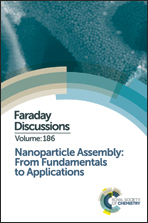Chiral self-assembly of helical particles
Abstract
The shape of the building blocks plays a crucial role in directing self-assembly towards desired architectures. Out of the many different shapes, the helix has a unique position. Helical structures are ubiquitous in nature and a helical shape is exhibited by the most important biopolymers like polynucleotides, polypeptides and polysaccharides as well as by cellular organelles like flagella. Helical particles can self-assemble into chiral superstructures, which may have a variety of applications, e.g. as photonic (meta)materials. However, a clear and definite understanding of these structures has not been entirely achieved yet. We have recently undertaken an extensive investigation on the phase behaviour of hard helical particles, using numerical simulations and classical density functional theory. Here we present a detailed study of the phase diagram of hard helices as a function of their morphology. This includes a variety of liquid-crystal phases, with different degrees of orientational and positional ordering. We show how, by tuning the helix parameters, it is possible to control the organization of the system. Starting from slender helices, whose phase behaviour is similar to that of rodlike particles, an increase in curliness leads to the onset of azimuthal correlations between the particles and the formation of phases specific to helices. These phases feature a new kind of screw order, of which there is experimental evidence in colloidal suspensions of helical flagella.
- This article is part of the themed collection: Nanoparticle Assembly: From Fundamentals to Applications

 Please wait while we load your content...
Please wait while we load your content...